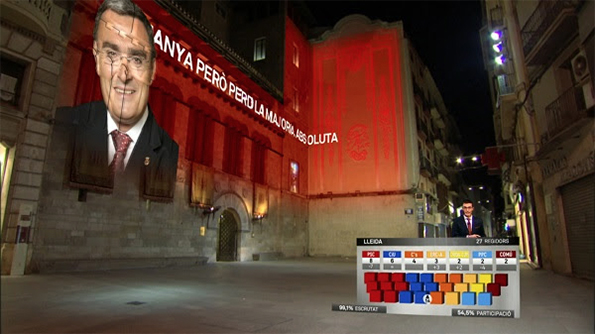TV3 chooses Orad for election coverage

Subscribe to NCS for the latest news, project case studies and product announcements in broadcast technology, creative design and engineering delivered to your inbox.
Spanish broadcaster TV3, the public broadcaster of Catalonia, utilized Orad’s graphic systems for coverage of the recent E-15 elections. Using sophisticated graphics, virtual mapping, virtual studios and augmented reality, TV3 was able to provide a dynamic look to viewers.
“It wasn´t about using a static image and adding graphics to it,” said Paulí Subirá, technical director of election shows, in a release from Orad. “The challenge was to give life and movement to the real image, and that the device could achieve the different movements from television, such as ‘travelling,’ without causing any loss of axis or interference when adding images and data.”

Images of the facades of the four Town Halls of the 4 main Catalan capitals were recorded in advance. These recordings were done using two cameras, so that two different points of view at different times of the day were offered. Once the real image and live presenters were inserted and data was added, the spectators were presented real time data on the buildings themselves with the presenters. Data was displayed from the four main Catalan Town Halls, projecting the image of possible winning mayors and colouring them with winning party´s colours, showing number of councillors, participation or percentage counted. In addition, the two presenters displayed the results with interactive virtual maps where each of the 947 regions was coloured with the winning party´s colour.
The election broadcast featured a sensorized camera relying on Orad’s Xync infrared free tracking for the short takes, map´s details and augmented reality elements, and a Jimmy Jib crane with Stypegrip system. The sensorized crane allowed large movements around augmented reality graphics, as well as taking different perspectives of the virtual set that helped to achieve the feeling of expansiveness and a better understanding of the graphics presented.
Virtual graphics system, including both the graphic set and augmented reality, were provided by Orad. During the elections night special show, two large sets were used, both located in different buildings and separated by a few hundred meters.
Despite the different geographic locations, the spectators had the feeling that the four presenters were sharing the same physical space.
“Another advantage that this technology offered was the ability to join two separate spaces and turn them into a single space for the viewer,” said Subirá.
The larger of the sets included 8 cameras, two of them over “travelling” and telescopic column, and another one over a 9 meter Jimmy Jib crane. This crane featured the Stypegrip system, a system capable of offering cranes with “tracking” or sensorization and, therefore, allowing working with augmented reality in real spaces.
Subscribe to NCS for the latest news, project case studies and product announcements in broadcast technology, creative design and engineering delivered to your inbox.




tags
Augmented Reality, election, election graphics, Graphics, orad, trackless virtual, tv3, virtual studio
categories
Featured, Graphics, MoGraph, Real-Time Graphics, Studio Technology, TV News Graphics Design, TV News Motion Graphics Design, TV News Virtual Set Design, Virtual Sets